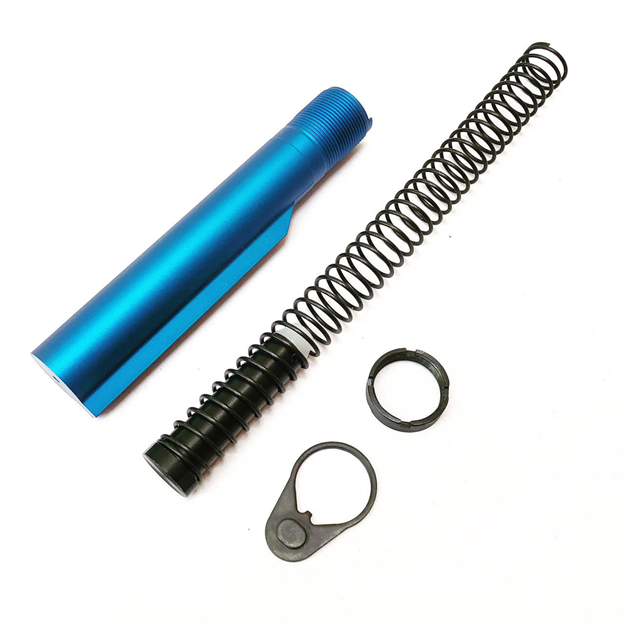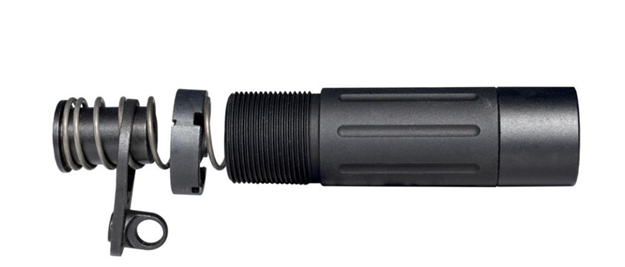If there’s one part of your AR-style rifle’s operation that’s mostly unknown, it has to be the buffer system. Pretty much everyone can tell you what the gas system does, where the bolt carrier group is, and what types of muzzle devices there are and what they do.
Yet the buffer tube and associated system more or less fly under the radar. This is perplexing (to say the least) considering the fact that the buffer tube and weights are as essential to firearm operation at the bolt carrier group and gas system. If your rifle didn’t have a buffer tube, when you fired the gun, the BCG would never return to battery.
At any rate, this short post will break down some details associated with the buffer tube system, buffer weights, length, and more.
What Are the Common AR Buffer Tube Lengths?

The two most common types of AR buffer tubes, broadly speaking, are mil-spec and commercial buffer tubes. Mil spec buffer tubes are 1.148 inches in outside diameter, and generally are 7.25 inches in length.
As for commercial buffer tubes, they have a slightly wider outside diameter, at 1.168 inches, and tend to be the same length.
Another common standard is the A2 buffer tube, which has a longer length, at 9 ⅝ inches. These are generally used with full-sized AR rifles with fixed stocks. There is another variant, an A5 buffer tube, which has a shorter overall length of 8 inches.
As for rifles with collapsible stocks, they are generally outfitted with carbine length buffer tubes. A carbine buffer tube is even shorter, at 7.25 inches; this accommodates both the shorter length of a carbine (hence the name) as well as collapsible or adjustable stocks.
What’s the Purpose of a Micro Buffer Tube
In addition to the standard buffer tube lengths mentioned here, there are even shorter versions that are generally used in AR-15 pistol builds. The whole reason for shorter AR pistol buffer tubes is to shorten the overall length of the pistol, making it more compact, easier to conceal, and easier handling, especially in tight quarters. Such short versions are known as micro buffer tubes.
Some micro buffer tubes are as short as 3.5 inches, making it possible to build a very short, very compact AR pistol. However, a micro buffer tube is only one way to cut down on the overall length. Another option is to build a bufferless ARP, which will not require a buffer system at all for cycling. These result in some of the smallest micro ARP builds of all.

What Do the Buffer Weights Do?
There are two key components to the buffer system; these are the weights and the spring. Both of them provide resistance to absorb some of the force of felt recoil carried by the momentum of the bolt carrier group.
The tube itself simply provides a housing for the buffer weight and buffer spring, which are the heart of the system and which lie at the center of the shooting experience.
As the bolt carrier group travels rearward, it will encounter the buffer weights and the spring; the weights provide static mass to help absorb some of the recoil, as does the spring, and the spring stores energy so that the buffer system can then return the BCG to battery.
There are several standard buffer weights, which will be covered here:
- Carbine buffer weight: 3 ounces, this buffer weight performs well with a variety of ammunition types, assuming a carbine length gas system.
- H1 buffer weight: 3.8 ounces, this is a very common buffer weight for short barreled rifles.
- H2 buffer weight: 4.6 to 4.7 ounces, the H2 buffer weight is a little bit heavier and performs better with mid-length gas systems. This is also the buffer weight of choice for rifles chambered in 5.56 NATO.
- H3 buffer weight: 5.0 to 5.4 ounces, this is one of the heaviest buffer weights and performs best with heavier cartridges, such as .50 Beowulf and .300 Blackout, because it provides much better recoil control.
- Pistol buffer weight: Between 5 and 8.5 ounces, pistol buffer weights are the heaviest of all, needed to ensure operability and a smooth shooting experience with lighter AR pistol builds.
Why Are H2 Buffer Weights So Common
The H2 buffer weight is likely the most commonly encountered AR buffer weight simply because it performs well with mid and rifle length gas systems as well as with rifles chambered in 5.56 NATO, which is in turn likely the most common chambering for AR style rifles. To shop our collection of H2 buffer weights, see the previous collection.
For More Information on Buffer Tube Systems
Whether you’re here for a heavier buffer, a micro buffer tube for your ARP build, a buffer tube kit, or are looking for gas blocks or other gas system components, take a look at what we carry and get in touch with us at Sales@MCSGearup.com if you have any questions.

